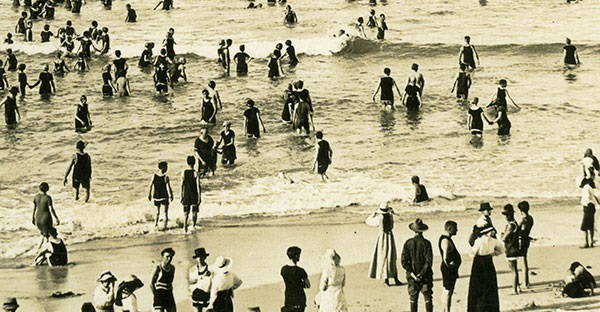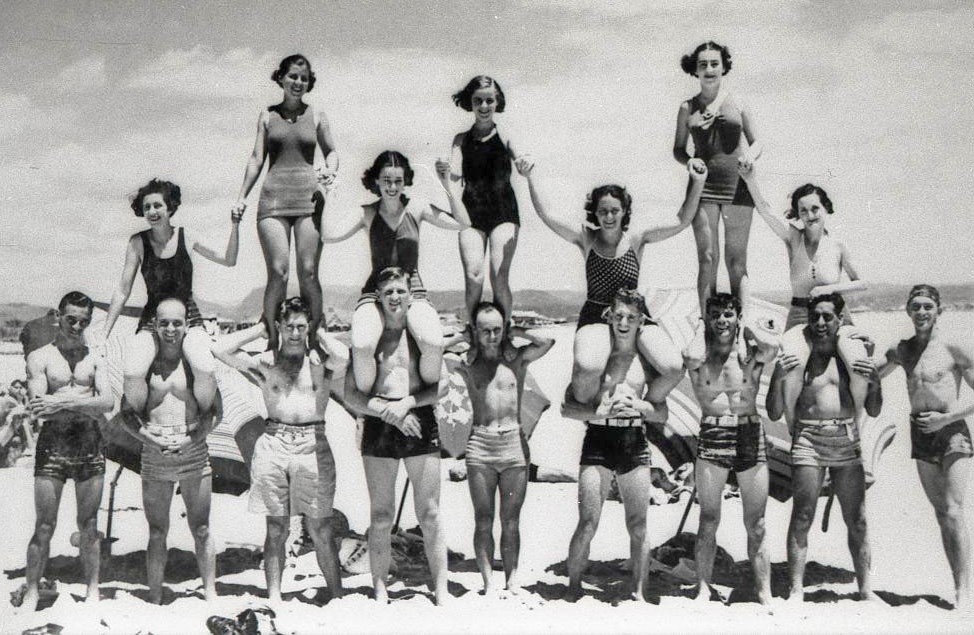Topless men not allowed
 Greenmount Beach, C.1910 (detail). TRM Collection TH48-20.
Greenmount Beach, C.1910 (detail). TRM Collection TH48-20.In 1833 the Sydney Police Act ruled that no one could swim in the sea between 6am and 8pm; this was known as the Daylight Bathing Law. The rule was flaunted by swimmers in the early 1900s and by 1902 local councils were making an effort to overturn the ruling. Swimmers could then enjoy bathing in the daylight, however they still needed to be ‘suitably attired’, which included modest clothing.
During the early 1900s all swimmers over eight years old had to wear neck-to-knee bathing costumes for men, and bathing gowns for women. Men and women couldn’t swim together until 1906, although this law was ignored by many.
 American servicemen and local women on the beach, 1944. TRM Collection TH150-09.
American servicemen and local women on the beach, 1944. TRM Collection TH150-09.Although the daylight bathing laws didn’t seem to come into effect on the Tweed, the restrictions on what could be worn in the sea certainly did.
By the 1930s swimming attire was becoming briefer, allowing more movement and freedom. At this time the beach lifestyle was becoming popular and surfboard riders were flocking to local beaches. Even though the local bylaw of neck to knee attire was still in effect, many disregarded the law.
In 1934 Coolangatta Town Council put forth a motion to stop men from wearing bathing trunks with no tops, which they declared, “beyond the border of decency”. However, in 1935, they officially rescinded the neck-to-knee bathing costume rule, and by 1938 men on the local beaches could wear trunks only. However these needed to have a proper belt to ensure they didn’t fall down in the surf and expose the wearer.
The battle to control what men and women could wear on beaches continued. However, by 1942 a huge contingent of American soldiers was stationed near local beaches and trunks soon became the standard. With the influence of Hollywood films, briefer swimsuit designs, and the lack of manpower to enforce the rules, the local councils quickly lost control of what could and couldn’t be worn on beaches.
By the early 1950s the bikini was introduced to Queensland beaches, and men’s swim shorts became shorter and tighter. In 1960 Speedo introduced men’s swimming briefs, now known as ‘budgie smugglers’, a popular choice for swimmers.
Tweed Heads & Coolangatta Surf Life Saving Club Swimsuit
Men’s navy blue one-piece lifesaver’s swimsuit with cloth badge sewn on denoting the Tweed Heads & Coolangatta Surf Life Saving Club, Greenmount Beach.
Swimsuit. Donated by Robert Longhurst. TRM Collection TH2003.215.